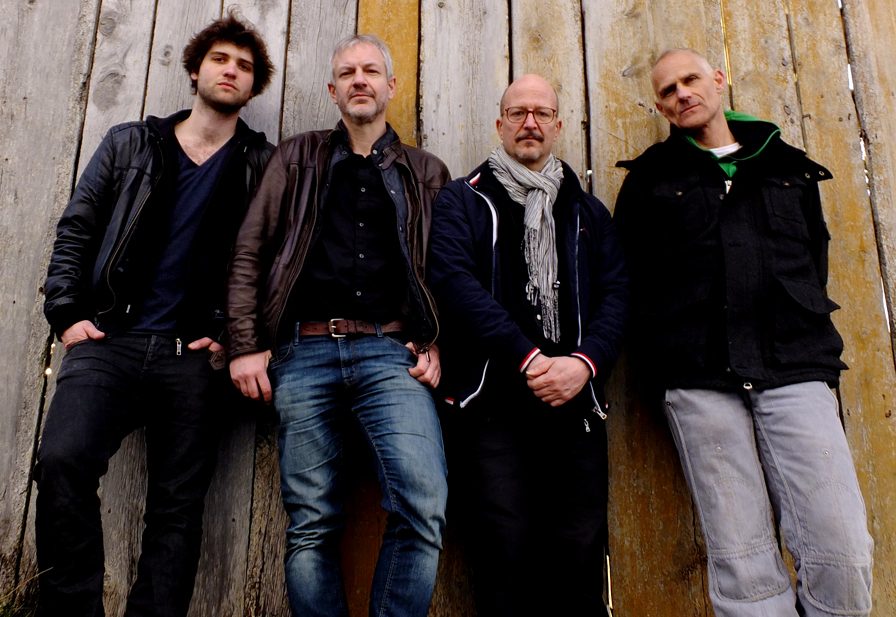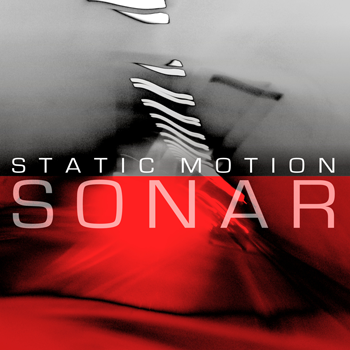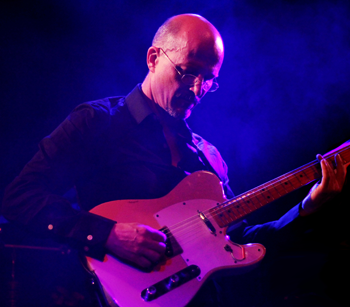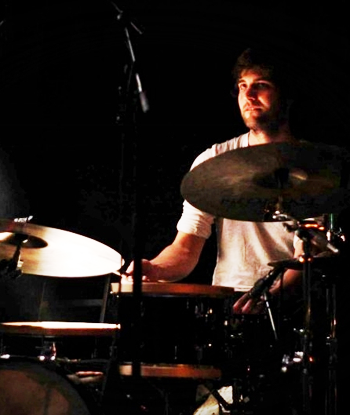
Donate to Innerviews
Since 1994, Innerviews has provided uncompromising, in-depth interviews with musicians across every genre imaginable. And it does that with no trackers, cookies, clickbait, or advertising.
Your donations are welcome to help continue its mission of highlighting incredible music and artists, without any commercial considerations.
Your contributions will be instantly transformed into stories and videos, and cover hosting and web management costs. Importantly, your dollars will help ensure Innerviews remains absolutely free to all visitors, independent of their ability to financially support it.
Please consider making a donation today by using the PayPal QR code below.

Sonar
Infinite Power
by Anil Prasad
Copyright © 2014 Anil Prasad.

We live in an era of sensory overload. Our lives have the potential to be saturated by multimedia elements every waking moment. The unfortunate reality is that the most unique music can float by in an instant without one having a chance to ponder its significance or profundity. But for children, wonder and intrigue remain integral to the process of discovering music. It’s that feeling Sonar sought to capture with the minimalist groove compositions on its fourth release Static Motion.
With that in mind, founder and guitarist Stephan Thelen set out some key principles to adhere to during the making of the album. The goal was to encourage the band, also comprised of bassist Christian Kuntner, drummer Manuel Pasquinelli and guitarist Bernhard Wagner, to work on a blank canvas. The environment was one in which anything could happen and the musicians were free to create without the limitations of traditional forms.
The group agreed to avoid conventional major/minor harmonies, but concentrate on tritone harmonics. Routine 4/4 beats were outlawed while polyrhythms and isorhythms were celebrated. Soloing and intentional virtuosity were jettisoned in favor of group interplay. And the majority of effects were left in their cases, allowing the group’s personality to emerge through its members’ hands and hearts.
Static Motion was also propelled by honing the material in front of audiences prior to recording. In an age of Pro Tools pastiche in which albums are often more compilations of remote contributions than organic interaction, this made a fundamental difference in the success and timelessness of the work. From there, the band went into the studio, working at Ocean Sound Recordings in Giske, Norway.
The end result is an album of sculpture-like compositions in which every contour serves a purpose. In fact, each piece on the album involves its own organizational construct situated within an overarching hierarchy to communicate the group’s vision, as Thelen explained in detail during this conversation.
Define the mission of Sonar.
When we started rehearsing in November 2010, there were a lot of ideas in the air that suddenly came together in a very convincing way. I very clearly remember the feeling we all had after our first rehearsal that the concept for this band was so strong and coherent that it just had to be good. Our main objective was to fuse a minimal aesthetic with the visceral power and dynamic range of a progressive rock band. Minimal music, especially the early music of Steve Reich, is a great influence on all of us and the minimal approach of doing as much as you can with as little material as possible still seems to me to be one of the best principles for a satisfying composition. We had also all been listening to Nik Bärtsch’s Ronin, who were based in Zürich, the same city we were rehearsing in. We really liked the way they combined repetitive minimal music with groove-based styles like funk and jazz and we thought that we could do something similar with minimal music and adventurous rock music.

We also knew we wanted a new and unique sound that would set us apart from all other bands. For me, it was important to find a solution to that challenge that didn’t rely on new technology, but on the strength of an idea. Partly inspired by Glenn Branca’s music, I had already been experimenting with a new tuning where the guitar is tuned to tritones—C – F#, C – F#, C – F#—but it felt like an almost too bold idea for the guitars and the bass to exclusively use that tuning. However, both Bernhard and Christian liked the idea, so we tried it out and never looked back. A new tuning is a great challenge for every guitarist because you’re forced to give up your licks and tricks and find new ones. In our case, we loved the natural harmonics of the tuning and decided to even go one step further and play as much as possible only using these harmonics. That led us to a whole new harmonic system that we call “tritone harmonics” and that has a rather dark, mysterious and strangely addictive timbre totally unlike anything you could create with conventional major or minor harmonies.
Another key point in minimalistic philosophy that was important for us is the somewhat paradoxical idea that in order to find new ideas, it is often better to reduce your options. Self-imposed limitations can give you a surprisingly strong sense of freedom because you realize that there are so many things you don’t really need. Intentional restrictions also sharpen your focus and force you to think harder, clearer and more creatively. We decided to use this principle not only for the musical material, but also for our equipment. After years of working with heavy amplifiers, sequencers, laptops, loop machines, samplers, and dozens of effect pedals, we felt the need to go back to our basic electric instruments and get the most out of them. Now we use only two guitars, a bass guitar, three small amps, and a very rudimentary drum kit, a fact that also has the very convenient side effect of making traveling a lot easier. The only effects we use on the guitars are reverb and perhaps a little bit of tremolo to get a sound that is slightly reminiscent of the 1960s surf guitar sound.
In addition to a new sound and new harmonies, we also wanted to find a new rhythmic language. Western music is incredibly underdeveloped when it comes to rhythmic complexity. There is nothing wrong with conventional 3/4 or 4/4 beats, but the fact that more than 99 percent of all Western music is written in those two time signatures alone is almost ridiculous. I always loved odd meters and in Sonar, we wanted to take that a few steps further by simultaneously playing two or more rhythms in different, often odd-metered time signatures to get really complex interlocking patterns and polyrhythms. So, for example, one guitar and the hi-hat are playing in 11/8, the other guitar and the snare drum are in 7/8, and the bass guitar and kick drum are in 5/4. This can be a real challenge for a group of players and only really works—and grooves—if the musicians listen very closely to each other and the drummer can hold it all together. Fortunately, Manuel is becoming a real master of polyrhythms and we can totally rely on him to guide us through the most difficult passages. The concept of a polyrhythm is also closely and elegantly related to the basic idea of minimalism. If you want to play minimal music, you have to have ideas about how to let simple things organically grow into complex things. Simultaneously playing two rhythms in different time signatures will do exactly that. It will take two simple patterns, let’s say a five- and a seven-beat pattern, and turn them into a much longer and complex 35-beat pattern.
A further important idea was to place collective group efforts way ahead of any form of individual showboating. We wanted to play more like a chamber orchestra that serves the needs of the music rather than a collection of soloists. There are actually quite a few improvised parts in our music and all the individual players have more freedom than you might think, but it never is a “solo” in the traditional sense.

What evolution do you feel Static Motion represents for the band?
It’s a huge step forward in experimenting with increasingly-complex polyrhythms in the field of groove-based minimal music. But it also looks back to the music that we listened to as teenagers, when music had a real sense of mystery and magic. For me personally, that meant mainly European progressive music of the early 1970s. Parts of the title track Static Motion, for instance, were inspired by King Crimson’s “Fracture” and Mahavishnu Orchestra’s “Meeting of the Spirits.” Part of “Continuum” was influenced by ELP’s “Tarkus: Eruption.” And some of “Triptych” was inspired by Shylock’s “Laocksetal.”
It’s probably fair to say that this CD is more progressive and colorful than our first CD A Flaw of Nature, which was deliberately more monolithic, austere and minimal.
Tell me about the creative process that informed the album.
There were five main stages: the composing of the pieces, the rehearsals, playing them live to an audience, recording them in Norway, and mixing them at my home studio in Switzerland. The composing was done by myself at home, mainly during the summer of 2012. My goal was to expand our vocabulary but still stay true to our reductive and minimalistic principles.
During rehearsals, we, in a very democratic way, discussed possible changes and rearrangements. Some pieces remained practically unchanged, others were completely rearranged and some discarded. Playing the pieces live also was a very important part of the process that mainly led to shortening, lengthening or completely dropping parts of the pieces.
The recording in Norway was a new and intense experience for us. For the first time, we lived together for four days and nights in an absolutely stunning and remote environment. The first three days were rather difficult. Things weren’t working quite as well as usual and for the first time, we were beginning to feel some pressure on our shoulders. Fortunately, on the fourth and last day, everything fell into place and we recorded most of the material that was used on the CD.
The mixing and editing was mainly done by myself with the other members of the band constantly giving me feedback and suggestions.
How did you document the music while it was being formulated?
I usually make a computer recording of the compositions using Logic. I then give these recordings and some lead sheets to the other guys so they can learn their parts. After we have rehearsed and perhaps rearranged the pieces, everybody writes down whatever is necessary for them to remember the arrangements or records rehearsal-room versions on a hard drive for reference.

Is the dynamic flow of the pieces carefully architected or is it an organic outgrowth of performing them together?
It’s definitely both, even if that seems to be a contradiction. At first, there’s usually an architectural idea to begin with. Then there is a very organic process of refinement where we try this idea out: If it works we will go with it and if it doesn’t we will change whatever seems necessary to make it better.
The best advice I ever got concerning the dynamic flow, the dramaturgy and the structure of a piece—or an entire CD or a whole concert—came from Robert Fripp who told me to first be very careful about the beginning, then to be very careful about the end, and finally to be very careful about the middle. It’s a simple idea, but actually very efficient.
The CD is symmetrically arranged as a triptych: three groups of three pieces. “Static Motion” is the first piece of the first group and “Vertical Time”—which is musically related to “Static Motion” in that it has a similar rhythmic structure, the same time signature and is in the same key—is the last piece of the last group. In the center of the middle group is “Triptych,” which is itself divided into three separate but musically related parts.
Describe the approach to recording the disc.
The tracks were all recorded live in the studio with the four of us playing in the same large room. Our objective was to get the bass and drums down as perfectly as possible, because we knew that in general we couldn’t fix them later. The guitars could be fixed, because we recorded them directly with a Line 6 Pod HD, so we knew we could get the same sound in any other studio.
There are some pieces like “Landslide,” “Static Motion” and “Tranceportation” where you hear exactly what we played together with practically no edits. Other pieces, like “Shadow Play” and “Vertical Time” have a few guitar overdubs on them. The overall amount of edits is very low with the exception of “Triptych,” where I even slightly changed the arrangement during post-production.
Our philosophy is to do as much as possible without technological help, so all the dynamics are heard as played. To give the album a certain weight and to make it compete with other CDs in terms of loudness, we used a limiter for the final mix, but other than that, we did nothing to alter or influence the dynamics.
How did performing this music in front of audiences, ahead of recording it, influence its form?
I believe it is crucial to play a piece live before it is recorded. Only then can you really decide if it works or not. A sensitive musician can immediately tell if an audience is drawn into the music or not. For instance, the duration of a section is probably too long if the audience visibly loses interest. Or if one piece gets a lukewarm response from an otherwise very supportive audience, you know that that piece is somehow not really working yet.

Provide some insight into the group's chemistry that allows this music to emerge.
Although we are a very diverse group of individuals in terms of musical and social background or age, Sonar has a very strong group spirit. I don’t consider it to be my band, even if I do most of the composing and conceptualizing. All important decisions are made democratically and there is a lot of good humor and respect for each other’s opinions in the band. I have known Christian for over 20 years, so he can usually tell very well if my ideas are forward-looking or if I’m falling back onto old schemes.
How do you collectively determine the duration of a groove before a change is required?
Because our music is concept-based, there is sometimes a conflict between a theoretical idea and its practical realization. For instance, if a groove consists of three different simultaneous rhythms, let’s say 3/4, 4/4 and 5/4, as in “Landslide,” it takes a rather long time—in this case 60/4, the least common multiplier—until the first beat of all three rhythms coincide and the whole cycle is completed. Sometimes, this can feel too long and we are tempted to trim the length of the groove, although this is clearly against the idea. Nik Bärtsch told me that Manfred Eicher once insisted on trimming the length of a Ronin groove on CD, but that they now, in a live context, play it the way it “should” be. So in Sonar, there are often discussions about how true to an idea you should stick. What’s more important, to be true to an objective idea or follow your subjective intuition? There’s no general answer I think and we decide differently from case to case.
How do you know when a piece is complete?
For a minimalist, that’s an easy question to answer. A piece is finished when there is nothing more that you can take away. You could also say that a piece is finished when the original concept or idea of the piece has been exposed with a maximum amount of clarity and elegance.
Do you consider the entire group to be a collective rhythm section?
There are certainly quite a few parts where the whole group plays tuned percussion and could be considered to be a collective rhythm section. The rhythmic aspect is certainly the most important and advanced element of our music and we deliberately don’t use very many melodies or chord changes in the traditional sense. For me, a melody tells a story in linear time while a pattern creates an atmosphere in vertical time. There is nothing wrong with telling a good story, but in Sonar we are more interested in creating atmospheres that give the listeners more space for their own thoughts and imagination. There is perhaps one exception on the CD, the track “Continuum,” which has a lot of little melodies—one of them from “Tarkus”—and even some chord changes.
What rhythm traditions influence Sonar’s output?
Odd-metered music in general is a very important influence, especially traditional music of Hungary and Bulgaria, including the music of Béla Bartók, and of course progressive music from the ‘70s, such as King Crimson and Mahavishnu Orchestra. Odd meters by themselves can sound a bit edgy, unstable and unnatural though, which is probably why many people don’t like them. However, if you combine an odd-metered rhythm with an even backbeat to a polyrhythm, like in “Landslide,” you can get very interesting results because you have a constant shifting of down- and upbeats which keeps the music alive and moving. So, polyrhythmic music in general is the second strong influence, especially the polymetrical groove music that was developed in Switzerland by Don Li and Nik Bärtsch in the first years of the new millennium.

Describe the relationship between your music and the cultural context that informs it.
Switzerland has a tradition of having many excellent, world-class drummers and Swiss musicians in general usually have a very good sense of rhythm. Clockwork precision is also a very Swiss virtue, so it is perhaps a bit more likely for a band like Sonar to come from Switzerland than from somewhere else.
For me, Sonar’s music has a Western, urban feel. Although I listen to a lot of world and ethnic music, I wanted Sonar to only use instruments from the culture I grew up in. In the beginning, we considered using ethnic percussion, including Asian gongs and cymbals, but we soon felt this is not what we wanted. I very much agree with Steve Reich who said that it is good to be influenced by the ideas of other cultures, but not to use their actual sounds and instruments.
What responsibility do you feel you have as musicians to push the creative envelope?
Sonar is the first band I have been a part of where I consciously made the decision that playing good or even great music is not enough. It had to be new and innovative as well. There are very many well-trained and excellent musicians today who can play fluently in almost any style, but I very rarely hear something really new and daring but still enjoyable—it’s almost always the same harmonies over the same rhythms. So yes, we do feel the need to push the creative envelope, but it is more a desire than a feeling of responsibility.
What’s the group's perspective on how evolving, pattern-based music affects the perceptual process of listeners?
We think that gradually evolving, pattern-based music gives the listener a much more active and liberating role in the ritual of performing music. It’s not about being passively entertained, about personal feelings or about admiring musicians with great technical abilities. It’s about players and listeners being together in the same space and at the same moment in time, breathing the same air, standing in awe of the seemingly infinite power of music and working together to gradually create something remarkable.
We also think that it’s a rewarding challenge to listen to the superimposition of different odd-metered patterns. At first you feel bewildered, not “knowing” but only “feeling” what is going on. Then, with a will to discover and to divide your attention—a good exercise in awareness—you slowly begin to understand what’s happening and can learn to switch your attention between the different rhythms. This is something I think can be a very satisfying and multi-dimensional musical experience.
Do you see the group's music as serving a purpose beyond music?
Music is only the medium—a “window to other worlds” as Jon Hassell has said. In my opinion, any band of musicians will make many non-musical statements by the way they interact as a group and how they behave on stage. In Sonar, it’s probably impossible not to notice that we are a rather disciplined bunch of guys who value precision and awareness, like to display an economy of means and clearly place group interaction above individual merits. In that sense, we are trying to show that the principles of minimalism really can work in a convincing way. It is very unfortunate that the term “minimalism” often has a negative connotation to it. Many people would say a minimalist is somebody who does his job carelessly, who is basically lazy and who only invests a minimum amount of energy. For us, a minimalist is quite the contrary. Rather, it’s somebody who pays a great deal of attention to details, who is as clear and as precise as possible about what he or she wants to say, who wants to get the most out of one idea before the next one is introduced and who discards anything that is superfluous.